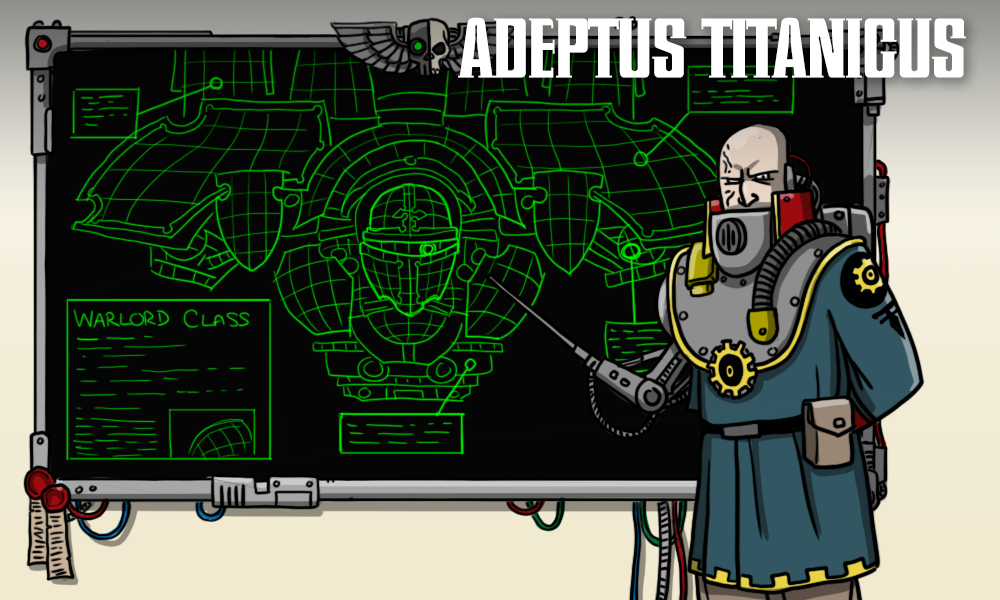Welcome back to Goonhammer’s series for aspiring Titan Principes. We here at Goonhammer’s own Collegia Titanica know that Adeptus Titanicus can seem intimidating to players unfamiliar with its particular quirks, but this series aims to equip you with everything you’ll need to play out epic clashes on the battlefields of the far future with your very own Titan Battlegroup. In this series, we’ll be taking a more in-depth look at the various Legios of the Collegia Titanica – exploring their origins and how to use them on the tabletop, from maniple selection and their loadouts, through to how to command them on the field of battle to secure ultimate victory.
Soggy: It’s a bit tricky to get photos of games at the moment, so first of all a big thanks to people in the community who shared their photos with us for this article. This includes tabletop_standard, Peitsa Veteli and artisans_of_vaul <3
Why is terrain important to having a good game?
In such a cinematic game about a literal clash of Titans, it’s important to have some terrain that sells the magnitude of the battle being fought, where a single stray shot from one of your God-Engines can level an entire hab-block. Appropriate terrain also helps to give a sense of the scale, these are huge Titans and features like buildings with little tiny windows and doors are a great reminder of that. Most importantly, due to their limited maneuverability and weapon arcs, having the right terrain will result in each player having to make meaningful decisions throughout the game.
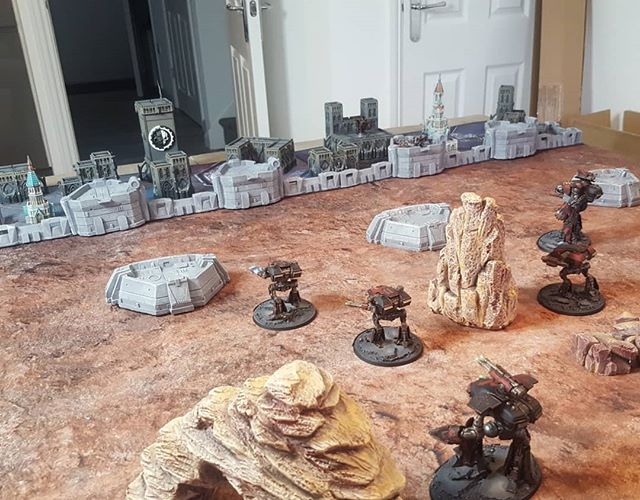
How does terrain work in AT?
There are different types of terrain in Titanicus ruleset, each which will impact the battle differently. A good combination of these will make for the most interesting battlefield.
Blocking Terrain is by far the most common feature on the battlefield, including colossal gothic buildings, megaflora, or just really really big rocks. These gargantuan objects are so large that they would stop even a Titan from moving through it, willing or not. However, depending on their relative size, larger God-Engines may be able to walk over/through smaller blocking terrain allowing them to ignore obstacles that would halt mere mortals. Specifically, if a piece of terrain is less than half of a Titan’s Scale in inches it can step over blocking terrain as long as it’s base can fully clear the entire piece. For example, a Warlord can step over anything that is less than 5” in height, a Warhound anything less than 3” in height.
Difficult Terrain is uneven ground that a Titan has to walk through slowly such as ruined buildings or a body of water. This slows down any unit moving through it, making each 1” the unit moves count as 2” of the unit’s movement. Where blocking terrain stops you from moving somewhere, difficult terrain just makes it more difficult to get there. Craters, tank traps, and ruined buildings make excellent ways to create firing lanes that don’t leave you completely vulnerable to a charging Warhound or Reaver. It’s not completely without risk, though: Questoris and Cerastus ignore difficult terrain, letting them punish overextended Titans who might otherwise think themselves safe.
Condit: Difficult terrain can also be created when you destroy other terrain on the table. If you’re planning to blow up that hab-block so you can charge through it, just keep in mind that you’ll only move at half speed through the ruins.
Dangerous Terrain is hazardous to the Titans to traverse and also counts as Difficult Terrain. It’s important to note that some Knights, such as Questoris and Cerastus with the Agile keyword, get to ignore Difficult and Dangerous Terrain. As you travel through difficult terrain, the more damage your Titans will take to their legs. Examples of this include minefields, magma or toxic sludge. Where difficult terrain makes it harder to get to your target, dangerous terrain makes it risky. Both are interesting terrain features, though you’ll want to apply dangerous terrain sparingly, as being punished for moving your Titans often feels bad.
Soggy: One of the most common ways to encounter dangerous terrain, if your opponent really hates you, is via Scatterable Mines.
If you’ve got the terrain on hand, a designer’s note recommends replacing destroyed Titans with a crater, wreck, or other similar feature that counts as both Difficult and Dangerous terrain. Adding this layer to the game adds more interesting mid-game changes to the board, potentially stalling advances and creating areas that suddenly need to be avoided.
Deadly Terrain is pretty self explanatory: any unit that moves into it is immediately destroyed. Some examples of this include ravines or warp anomalies. You won’t see this often, but could be used to create a battlefield with some interesting choices regarding positioning – especially if you have quake cannons or other weapons with the Concussive trait to try and knock someone into those terrain features.
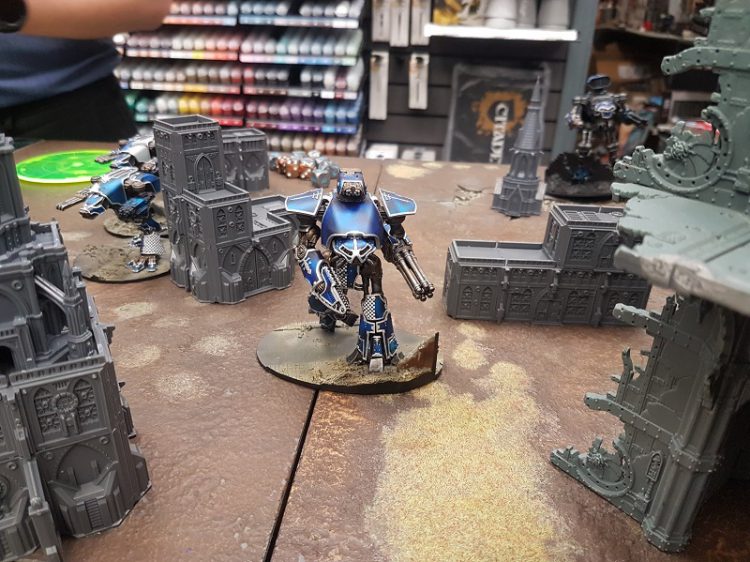
Destroying Terrain
In many wargames, terrain is an immutable fact of life – it’s there, and you just have to deal with it. And while that’s true in Titanicus as well, the optional rules for Destroying Terrain give you another option to deal with an inconvenient building: blowing it up with your huge guns. If you’re going to use these rules (and once you’ve got a few games under your belt, we recommend that you do), you’ll need to assign armor values to the various buildings on the table. The rulebook suggests values ranging from AV9 for forests up to AV13 for a reinforced industrial building, and we find that that generally works out. Keep in mind that a Reaver’s armor is in the 10-11 range for a direct hit – we recommend assigning most armor values at about the same. The increased durability of your god-engines over civilian armor is represented by their deep structure tracks, while the buildings on the table are at risk of being destroyed from any hit.
Stray Shots
If you want to really turn up the heat, consider using the stray shots rule. Normally, only missed shots with Blast weapons will scatter, but this rule lets any of your missed shots have a chance of taking out a stray building. Strictly speaking, it’s not a “terrain rule,” but combined with the rules for destroying terrain it means that even shots that go wide of your intended target can have a major impact on the outcome of the game.

What makes for an interesting table?
This is entirely subjective and down to personal taste but there are few guidelines we follow when creating our tables: serving the narrative, a reasonable amount of line of sight, and placing terrain densely enough to give interesting choices to maneuver around.
Narrative
What is the story you are trying to convey, are you fighting in a dense urban centre or in an arid desert littered with mesas? Use the terrain you have on the day to help contribute to the cinematic spectacle that is Adeptus Titanicus. The narrative may have one side as the aggressor and the other holding the line, tipping the distribution of terrain. Don’t be afraid to build your table to serve the narrative of the game you’re trying to tell. However, if it’s going to be imbalanced, make sure to run that by your opponent before you start – there’s nothing more frustrating than only realizing halfway through a game that you’d been set up to fail.
Ideally, you’ll look for ways to forge a strong narrative without putting one side or the other at heavy disadvantage. Destroyed Titans, ruined buildings, and craters from weapon impacts are all ways to “sell” the desolate hellscape of the various battlefields of the Horus Heresy without forcing one of the players to take a disadvantage. Get creative and have fun with it.
Blocking Line of Sight (LOS)
In addition to the categorisation of terrain types in the rules there’s another way of looking at terrain which is mostly related to its size and shape. It is vital to have a good array of sizes to create the landscape as playing in a more dense environment will force you to make decisions about where you’ll commit your firing arcs.
- Large items that can fully block LOS on a Warlord Titan on the table will make it so that a Fire Support Warlord can’t just deploy in a corner and take pot shots all game
- Smaller terrain that will fully block smaller engines or knights will allow players to possibly avoid getting vaporized by Volcano Cannons before they get into effective range.
Remember that not all terrain needs to be fully LOS blocking, having some megaflora that gives partial obstruction can make all the difference between that shot landing or going astray.
Bair: Also important to remember that line of sight is checked from the weapon – Warlord arms sit much lower than their carapaces, so not all terrain needs to be as tall as a Warlord to be effective.
Placement + Density
The tricky part is where it all comes together and deciding what to put where. To keep this short there are a few things we have in mind when putting terrain down:
- Have at least one or two LOS blockers near the middle of the table, ideally high enough to hide a Warlord behind.
- However, even terrain that doesn’t completely obstruct will impose penalties to hit. Waist-high terrain can make it more difficult to hit a Warlord, which is sometimes all you need.
- Have items on the sides which can partially obstruct Warhounds or fully obstruct Knights to allow them to flank.
- Having around three firing lanes means that players will have to split their forces accordingly, or deal with the consequences of bunching up. Remember to leave a few gaps to let Titans through, but remember that you don’t have to make the board completely accessible to everything.
- Be cognizant of how close together the various terrain elements are. Anything closer together than about 6” will allow Warhounds and Revers to move between them without exposing themselves to too much return fire, and anything closer than 10” or so will allow knights to move between unmolested. Leaving a larger gap or two here and there will force players to either risk being shot at or push reactors to get the extra speed to stay safe.
- Try to keep things relatively balanced between each side of the table. This isn’t to say make it fully symmetrical, but give both players something to work with.
- The more terrain you add, the more it can favour knights and smaller chassis and vice versa. Find a balance that works for you and your group.
A good starting point is to try to get your table about 25% covered by terrain, and vary the heights to create some interesting tactical space to play with. Try to get most of it in the “mid-height” range of around 3” or 4”, with some smaller scatter terrain and a handful of larger pieces. This will give you plenty of places for your smaller engines to try and hide without making it impossible for your opponent to hit back.
Soggy: Personally we would rather play with too much rather than too little. What I find works for me is put on clearly too much terrain and then wind it back a little.
Condit: Plus, if you’re playing with destructible terrain rules and realize there’s too much on the table mid-game, that’s a solvable problem. It’s much harder to get terrain back on a table that’s too bare.
What can I use to make a battlefield?
The epic scale of Adeptus Titanicus is different from the usual 28mm scale which the majority of other wargames use, meaning that you might need to start a new collection. There’s plenty of options out there, here’s just a handful of options to consider:
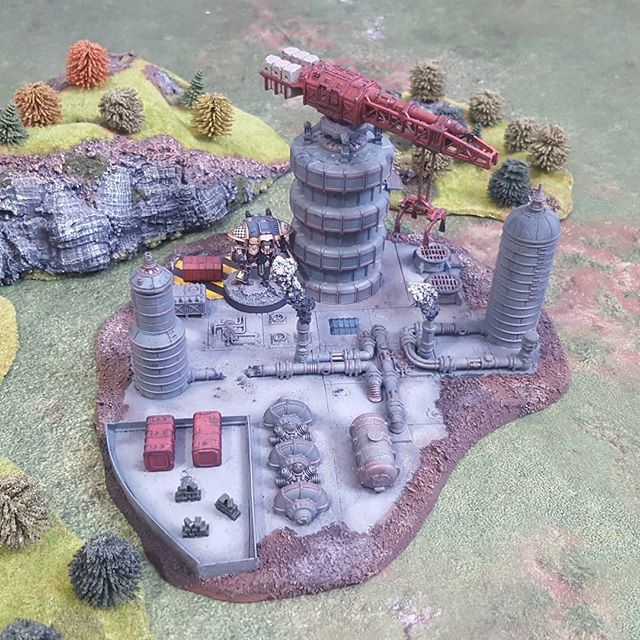
- Games Workshop have a few great kits including the Civitas Imperialis which is entirely modular, allowing you to create small buildings or massive skyscrapers which can eclipse even Warlord Titans. The Manufactorum Imperialis kit is a great source of scatter terrain, from the dinky Munitorum containers to the cranes which was great at providing partial obscuration.
Condit: I love these kits, but outfitting an entire table with them can get a bit expensive. They’re perfect for centerpiece terrain and objectives, and the tiny munitorum containers are adorable.
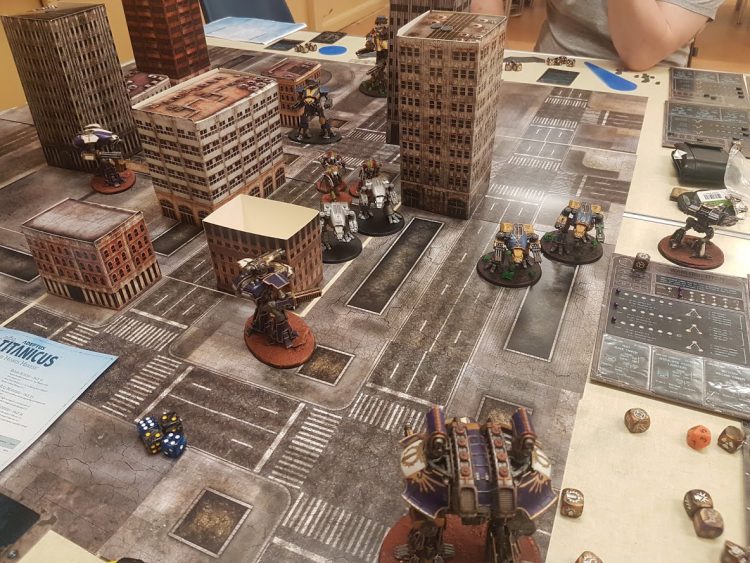
- TTCombat’s CityScape box is one of the cheapest options out there to quickly get a dense urban battlefield. Initially intended for their Dropzone Commander game, the scale is pretty close and has loads of LOS options.
Soggy: It’s personally what I use, the one thing that I would suggest is picking up some smaller scatter terrain to provide partial obstruction so that LOS isn’t a binary equation.
Condit: This is also the most portable option, which will let you bring a tactically interesting battlefield with you to your games without having to worry about carrying space.
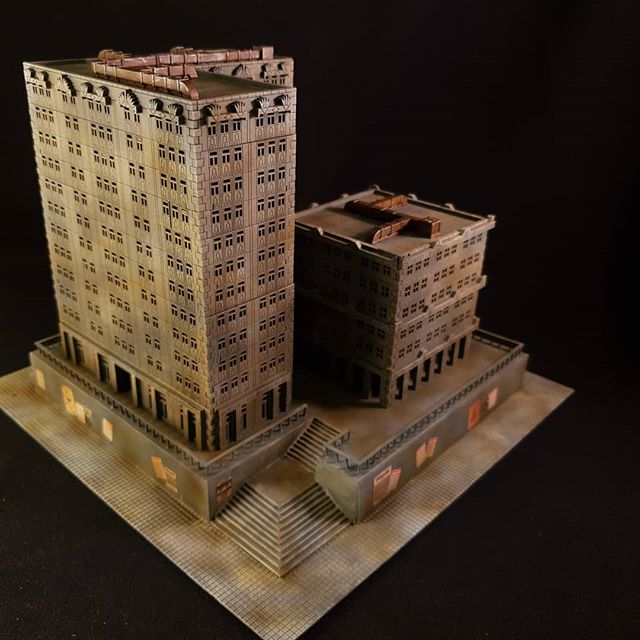
- MDF terrain is another good option with solid durability. Due to the competition in this space from different outfits it can be quite affordable, so it pays to shop around.
- Model Train supplies in the N scale can be a great source of buildings or other features for your battlefields. Whilst a lot of it isn’t in the grimdark style, there’s a lot of inspiration to be found with train modellers.
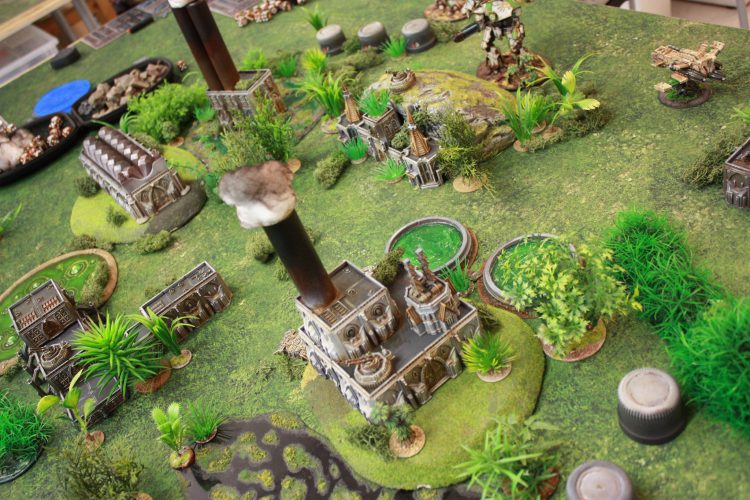
- Instead of buying terrain you can take the DIY approach, where the possibilities are endless and easier on your wallet. Use whatever you’ve got lying around or be creative and repurpose other items, such as the above making good use of fish tank plants. Large blocking terrain can be made easily by carving blocks of foam to shape, just remember to cover in watered down PVA glue so that spray paint doesn’t disintegrate it.
Aside from what you put on the battlefield, there is what you actually put it on. There are a number of vendors out there, such as TableWar or DeepCut Studio, who make mats in the right scale which will bring everything together. If you’ve got a 6’x4’ mat, you can also use that, but will probably want to mark off a 4’x4’ playing area unless you’re playing a truly massive game. That’s fine, though, as the extra space will give plenty of room for you and your opponent to set up your terminals.

Build It Up to Break It Down
After all the consideration of setting the stage for the ensuing titanic battle, it’s now time for collateral damage to tear it down again. Even more so than many other systems, terrain is essential to have a balanced and thematic game of Titanicus. We hope we’ve given you some ideas for creating your battlefields to wage war over.
